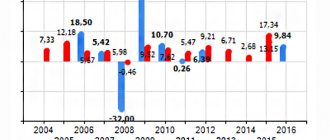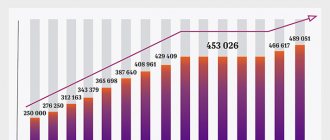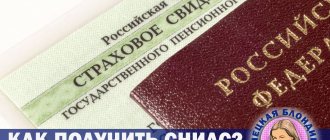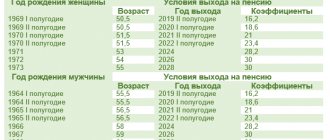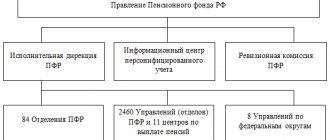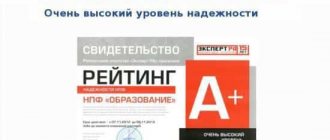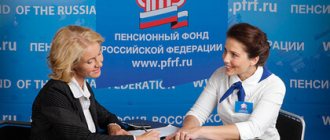| Pension Fund of the Russian Federation | |
| Pension Fund | |
| Type of organization | Pension Fund |
| Managers | |
| Chairman of the Board | Drozdov Anton Viktorovich |
| Base | |
| Date of foundation | December 22, 1990 |
| Number of employees | 114,300 (in 2020)[1] |
| pfrf.ru | |
| Pension Fund of the Russian Federation on Wikimedia Commons | |
The Pension Fund of the Russian Federation
(
PFR
) is the largest organization in Russia providing socially significant public services to citizens. Founded on December 22, 1990 by Resolution of the Supreme Council of the RSFSR No. 442-1 “On the organization of the Pension Fund of the RSFSR”[2].
As a state extra-budgetary fund of the Russian Federation, the Pension Fund of the Russian Federation was created for the state management of funds of the pension system and ensuring the rights of citizens of the Russian Federation to pension provision. The budget of the Pension Fund of the Russian Federation is approved by the State Duma of the Federal Assembly of the Russian Federation in a separate law, together with the adoption of the Federal budget of the Russian Federation. The share of the Pension Fund's budget in Russia's GDP is 10.8% in terms of income and 10.2% in terms of expenses. The Pension Fund of the Russian Federation pays pensions to over 40 million pensioners[3] and social benefits to 20 million beneficiaries, and maintains personalized records of the pension rights of insured persons[4] - for over 128 million Russian citizens.
Since 2005, there has been a deficit in the pension system, which is covered by transfers from the budget. However, the deficit of the pension system is several times smaller than the deficit of the pension fund, due to the transfer of social obligations unrelated to the payment of pensions to the Pension Fund[5]. According to Nikita Krichevsky, until 2005, the Russian pension fund had a budget surplus: in 2003 - 100 billion, in 2004 - more than 66 billion rubles[6].
Pension Fund structure
The structure of the Pension Fund includes 8 Directorates in the Federal Districts of the Russian Federation, 83 Branches of the Pension Fund in the constituent entities of the Russian Federation, a branch in Baikonur (Kazakhstan), as well as about 2,500 territorial directorates in all regions of the country. The Pension Fund system employs more than 100,000 workers[7]. The highest body is the Board of the Pension Fund; the Executive Directorate of the Pension Fund is responsible for its executive functions.
In relations with policyholders, insured persons and pensioners, the territorial departments of the Pension Fund of the Russian Federation are separate legal entities[8].
Pension Fund structure diagram
The large volume of tasks assigned to this organization and the impressive staff determines the complex organizational structure.
The easiest way to present it is in the form of the following diagram:
The main administrative body of the fund is the board. Drozdov A.V. has been the head since 2008. It is the chairman who approves the fund’s budget and also makes key decisions on issues related to the functioning of the pension system.
The board also includes deputy chairmen. Each of them specializes in certain areas of the Pension Fund’s activities.
An integral part of the structure of the pension fund is the audit commission. Its task includes internal audit, including checking the validity of spending the organization's budget.
The information center appeared in the structure of the Pension Fund quite recently - in 2020 . His activities are aimed at supporting electronic systems in the organization.
About the executive directorate
The executive directorate is headed by one of the deputy chairmen of the PFR board. This is the basic structure that determines the nature of the fund's ongoing activities.
The functions of the executive directorate are:
- determination of the Pension Fund budget, analysis of its revenue and expenditure parts;
- distribution of funds by region;
- carrying out accounting and reporting provided to the board;
- making forecasts regarding the situation of the pension system as a whole.
The Executive Directorate carries out a supervisory function over the activities of local territorial bodies.
Territorial apparatus
The territorial bodies of the Pension Fund have a hierarchical structure. These include:
District departments
There are 8 district departments in total. Their number is equal to the number of federal districts in the country. Their main tasks are:
- supervision of the activities of regional branches
- planning the work of Pension Fund bodies;
- coordination of local management activities;
- implementation of statistical accounting in the jurisdictional territory;
- participation in the formation and preparation of the fund's budget.
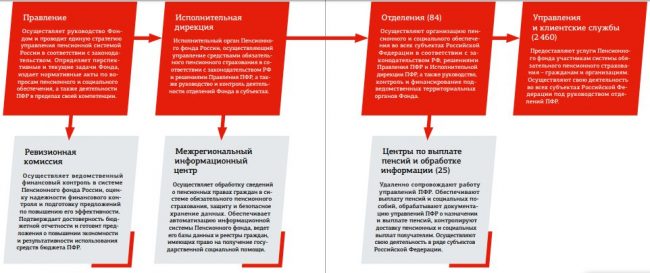
Territorial branches
Territorial branches operate in a specific region, where they are responsible for:
- administration of insurance premiums;
- control of collection of contributions;
- maintaining personalized records;
- coordination of local departments.
Attention! Regional branches receive complaints about unlawful actions of employees of municipal departments of the Pension Fund of Russia in the order of subordination.
Directorates and departments in cities and districts (municipalities)
It is these grassroots structures of the territorial apparatus that directly work with citizens. The responsibilities of their employees include:
- assignment of pension payments, including acceptance of relevant documents;
- accepting applications for maternity capital, issuing certificates;
- delivery of pensions;
- maintaining personalized records;
- administration of insurance premiums;
- consulting on pension issues;
- ensuring co-financing of regional social programs.
The Pension Fund of the Russian Federation is an extremely important and significant structure, the activities of which affect almost every citizen of our country. For successful and efficient work, an effective structure was developed, which, with minor changes, has existed for almost 30 years.
Socially significant functions of the Pension Fund
Among the socially significant functions of the Russian Pension Fund[7]:
- appointment and payment of pensions;
- accounting of insurance funds received under compulsory pension insurance;
- assignment and implementation of social payments to certain categories of citizens: veterans, disabled people, disabled people due to military trauma, Heroes of the Soviet Union, Heroes of the Russian Federation, etc.;
- personalized accounting of participants in the compulsory pension insurance system;
- interaction with policyholders (employers - payers of insurance pension contributions), collection of arrears;
- issuance of certificates for receiving maternity (family) capital;
- payment of maternity capital funds;
- management of pension system funds;
- implementation of the Program of state co-financing of voluntary pension savings (56-FZ of April 30, 2008, also known as the “thousand for a thousand” program);
- since 2010 - administration of insurance funds received under compulsory pension insurance and compulsory medical insurance;
- since 2010 - the establishment of a federal social supplement to social pensions in order to bring the total income of a pensioner to the pensioner’s subsistence level.
Personalized accounting in the compulsory pension insurance system
Data on the payment by policyholders (employers) of mandatory insurance premiums for an employee, information on insurance (work) experience are reflected on the individual personal account of the insured person, which is maintained by the Pension Fund of the Russian Federation for each officially working citizen of Russia. The procedure for maintaining this personal account is regulated by Federal Law dated April 1, 1996 N 27-FZ (as amended on December 29, 2015) “On individual (personalized) accounting in the compulsory pension insurance system”[4]. Any citizen of the Russian Federation who has a SNILS can check information about the payment of mandatory insurance contributions by his employer on his individual personal account with the Pension Fund of Russia using the Internet portal “Gosuslug”[9].
What are the pension fund funds made of?
Today the budget is formed from:
- Insurance contributions made by both employers and citizens. These contributions include contributions from the following insurers: persons who pay money to citizens (this includes various organizations, including individual entrepreneurs); entrepreneurs of various levels; ordinary citizens who have entered into agreements with the pension fund;
- Funds allocated from the country's budget;
- Voluntary contributions from citizens;
- Other income to the organization.
Contributions - income of the Pension Fund
See also Compulsory social insurance in Russia.
The standard rate of contributions to the Pension Fund is 22% of the organization’s payroll, while contributions are not included in the salaries of individual employees, but are taken into account by the pension fund when maintaining their accounts[10]. These contributions are divided into the insurance part and the funded part of the pension.
Until 2010, contributions to the Pension Fund were taken into account as part of the unified social tax.
From January 1, 2010, the unified social tax was abolished, and instead direct insurance contributions of employers (policyholders) to three extra-budgetary funds were established: the Pension Fund of the Russian Federation, the Federal Compulsory Medical Insurance Fund and the Social Insurance Fund. In 2010, the total volume of insurance contributions will remain at the level of the Unified Social Tax rate - 26%, of which 20% will be directed to the Pension Fund of the Russian Federation (for compulsory pension insurance). In this case, contributions will be paid from annual earnings up to 415 thousand rubles. If annual earnings exceed 415 thousand rubles, contributions in excess of 415 thousand rubles are not collected, but pension rights in excess of this amount are not formed. From 2011, the amount of total contributions will increase to 34%, of which 26% will be contributions for compulsory pension insurance. This system makes it possible to significantly increase the level of pensions in the country. For persons who are fully covered by the insurance system, the coefficient of replacement of wages with a pension with which insurance premiums were paid will be at least 40% after 30 years of paying these contributions upon the occurrence of an insured event (that is, old age, determined by the citizen reaching the age established by law - 55 years for women and 60 years for men).
Also, since 2009, citizens have the opportunity to make voluntary contributions to the funded part of their pension. The law[11] provides for two parties to co-financing a citizen’s contributions - the state (which doubles the amount to at least 2 thousand, but not more than 12 thousand rubles) and the employer (which receives a tax deduction for co-financing employee contributions up to 12 thousand rubles).
Part of the long-term pension provision mechanism for citizens of the Russian Federation is the Russian National Welfare Fund[12]. As of April 2020, according to the Russian Ministry of Finance, the total volume of the fund amounted to 4,134.27 billion rubles (73.33 billion US dollars)[13].
Before transferring funds to management companies and non-state pension funds, the Pension Fund temporarily places them in commercial banks. Thus, according to the results of 2016, he received an income from such investment in the amount of 2.97 billion rubles, which is 10.58% per annum[14].
Types of pension funds.
Today there are two types on the territory of the Russian Federation: state and non-state.
State Pension Fund
The Pension Fund of the Russian Federation is an off-budget monetary fund for a special purpose, which is formed according to the model of an independent financial and credit organization. This organization is required to manage pension insurance funds and some banking procedures at the state level.
The money in the state pension fund is the property of the state, but is not included in the budget and cannot be withdrawn.
The foundation operates on the principle of intergenerational solidarity. Thus, pension contributions paid to citizens while working are made from an insurance premium, which is deducted from the citizen’s earnings on a monthly basis. That is, people currently working receive money, and part of it is given to those who are now retired and are supported by the state for their work in the past.
For those who are working now, the pension will be paid by future generations, that is, the whole process has a cyclical principle, only the participants in the entire chain change.
Non-state pension fund
This organization provides assistance to citizens in accumulating funds to ensure a dignified old age. For each employed person, the employer contributes money to these funds, and the funds, in turn, make investments with it to avoid the depreciation of money over time. After a person retires, this money is paid as a pension. Today, there are two ways to significantly increase your pension with the help of non-state pension funds:
- Increasing the funded part of the state pension;
- Formation of an additional pension.
Many foundations today engage in both types. If a person is satisfied with the non-state option and its methods of managing money, then saving money for an additional pension can be done there. However, this action is carried out by concluding an additional agreement and opening another account. There is also the possibility of concluding an agreement with another fund.
Performance indicators
| Index | 2010[15] | 2011[16] | 2012[17] | 2013[18] | 2014[19] | 2015[20] | 2016[1] | 2017[21] |
| Number of pensioners, million people | 39,7 | 40,2 | 40,6 | 41,1 | 41,46 | 42,7 | 42,9 | 43,5 |
| Budget revenues of the Pension Fund of Russia, billion rubles | 4 600 | 5 256 | 5 890 | 6 388 | 6 159 | 7 127 | 7 626 | 8 260 |
| Receipt of contributions for compulsory pension insurance, billion rubles | 1 900 | 2 815 | 3 026 | 3 459 | 3 694 | 3 864 | 4 132 | 4 482 |
| Receipts from the federal budget, billion rubles | 2 640 | 2 400 | 2 800 | 2 840 | 2 410 | 3 100 | 3 355 | 3 677 |
| Pension Fund budget expenditures, billion rubles | 4 200 | 4 922 | 5 451 | 6 379 | 6 190 | 7 670 | 7 830 | 8 319 |
| Pension Fund expenditures on pensions, billion rubles | 3 700 | 4 081 | 4 524 | 5 250 | 5 406 | 6 201 | 6 430 | 7 167 |
| Pension Fund expenses on maternity capital, billion rubles | 97,1 | 171,3 | 212,4 | 270,7 | 365 | 312 |
What does a pension fund do?
What does the pension fund do and what are its main tasks:
- Together with the tax office, this organization provides targeted contributions and accumulates insurance premiums;
- Finance expenses;
- The Pension Fund is obliged to capitalize its own funds, as well as attract investors;
- This organization keeps individual records of citizens who have entered into a pension insurance agreement, optimally organizing this entire process;
- The Pension Fund is taking measures aimed at collecting funds from ordinary people and legal entities in order to provide social benefits to disabled people who have received work-related injuries;
- Together with the tax office, it controls the receipt of insurance premiums for their full amount from employers, and also controls the appropriateness of their spending, etc.
Scandals
In February 2020, the Anti-Corruption Policy Center of the Yabloko party (ACP) discovered a contract according to which the Russian Pension Fund (PFR) will spend 27 million rubles on business trips for employees in 2020 without bidding.[22] In May 2020, the FAS confirmed violations when the Pension Fund spent 150 million rubles on employee business trips.[23]
Since mid-2020, on the basis of its internal letter (signed by the Deputy Chairman of the Board Liliya Ivanovna Chizhik), the Pension Fund of the Russian Federation has been refusing to provide monthly additional financial support (330% of the social pension) to laureates of the Russian Government awards who retire and stop working . As a result, they find themselves in significantly worse material conditions than the laureates who applied for the bonus earlier and are still receiving it. There were lawsuits initiated by the affected pensioner laureates. Most of them were won[24][25].
Efficiency and efficiency
The Russian Pension Fund ranks first in the world in terms of the number of employees: 121,670 people. For example, the number of employees of the Social Security Administration in the United States is more than two times smaller, and the population of the United States is more than twice that of Russia, and the volume of pension and social benefits is almost nine times larger. In Japan, with a population similar to Russia, Nihon Nenkin Kikou employs 27 thousand people, of which only 15 thousand work on a permanent basis[26].
Professor of the Department of Finance and Prices of the Russian Economic University. G.V. Plekhanova Yulia Finogenova noted that the Pension Fund of the Russian Federation has extremely limited obligations to inform its participants, for example, the Pension Fund of the Russian Federation did not have the obligation to inform clients about possible losses of investment income when changing insurers, as a result, in some years, up to 90% of transitions turned out to be premature, and therefore unprofitable[27]. Due to the lack of full information to the insured person about the loss of investment income, even those who decided to transfer from the Pension Fund of Russia (PFR) to non-state pension funds (NPFs) were “silent” [28] who lost out on an early transfer, since they could have done this with the preservation of income no earlier than 2020 [29].
The Pension Fund is also known for its involvement in a scandal involving illegal transfers of pension savings from the Pension Fund to NPFs.
In August 2020, against the backdrop of a discussion of the Draft Law on Pension Reform in Russia, which envisages an increase in the retirement age, Boris Titov, Commissioner under the President of the Russian Federation for the Protection of the Rights of Entrepreneurs, drew attention to the fact that one of the main reasons for the lack of funds for paying pensions in Russia is exorbitant and senseless expenses for the maintenance of the Pension Fund of the Russian Federation. The business ombudsman considered the infrastructure of the fund to be costly and unnecessary in the context of the development of information technology, and proposed transferring the functions of the Pension Fund to the Russian Treasury and Multifunctional Centers (MFC). In 2020, the Pension Fund of the Russian Federation employs more than 110 thousand officials to maintain the pension accounts of Russians, the buildings it owns are the most luxurious in all republican capitals and regional centers, and about 1.5% of all pension savings of Russians are spent annually on servicing the Pension Fund of the Russian Federation itself (this is tens of billion rubles). Numerous buildings of the Pension Fund throughout Russia, according to this action plan, should be transferred to the ownership of the constituent entities of the Federation for the organization of centers for training older people in new qualifications. Such measures will allow the state to free up significant reserves for paying pensions without increasing the retirement age[30].
Notes
- ↑ 12
Annual report of the Pension Fund for 2020 - Resolution of the Supreme Council of the RSFSR No. 442-1 “On the organization of the Pension Fund of the RSFSR” Archived on January 20, 2013.
- Pension Fund of the Russian Federation - In November 2010, there were no failures in the payment of pensions and benefits
- ↑ 12
Federal Law “On individual (personalized) registration in the compulsory pension insurance system” dated 01.04.96 N 27-FZ - Nikita Krichevsky: Statements that the Pension Fund of Russia does not have a budget deficit are hypocrisy
- Personal blog of Nikita Krichevsky. About Nikita Isaev and the Pension Fund budget deficit
- ↑ 12
About the Pension Fund - Participants in legal relations regarding compulsory pension insurance. base.garant.ru. Retrieved April 2, 2020.
- Article 16. Rights and obligations of the bodies of the Pension Fund of the Russian Federation related to the implementation of individual (personalized) accounting / ConsultantPlus. www.consultant.ru. Retrieved April 2, 2020.
- Federal Law of December 15, 2001 N 167-FZ “On Compulsory Pension Insurance in the Russian Federation”
- Federal Law of April 30, 2008 N 56-FZ (as amended on July 27, 2010) “On additional insurance contributions for the funded part of the labor pension and state support for the formation of pension savings”
- “The Purpose of [NWF]”
- National Welfare Fund. Statistics.
- At the end of 2020, the Pension Fund increased the pension savings of Russians by 2.97 billion rubles. www.pfrf.ru (April 6, 2017). Retrieved April 18, 2020.
- Annual report of the Pension Fund for 2010
- Annual report of the Pension Fund for 2011
- Annual report of the Pension Fund for 2012
- Annual report of the Pension Fund for 2013
- Annual report of the Pension Fund for 2014
- Annual report of the Pension Fund for 2020
- Annual report of the Pension Fund for 2020
- Inc., TV Rain,
. Yabloko learned about the Pension Fund's plans to spend 27 million rubles on business trips for employees. Retrieved May 20, 2020. - Inc., TV Rain,
. FAS found violations when the Pension Fund spent 150 million rubles on business trips for employees. Retrieved May 20, 2020. - “Reckoning with the laureates” // Moscow city branch of the Communist Party of the Russian Federation, official website.
- The Pension Fund is deceiving the laureates of the Russian Government Prize. trv-science.ru
- Fund with more Rating of the most effective and ineffective pension services
- “Translation difficulties. Why do citizens lose savings when moving from fund to fund” “Rossiyskaya Gazeta” - Federal issue No. 7339 (173) dated 08/06/2017.
- “Pension funds do not let citizens go” Vedomosti, March 19, 2018.
- “Pensions are lost during the transition” Newspaper “Kommersant” No. 44 dated March 16, 2018, p. 1.
- NEWSru.com, August 2, 2020. The business ombudsman suggested “buying additional” work experience, and paying extra for early retirement
Links
- Official website of the Pension Fund of the Russian Federation
Pension Fund budget by year
- BUDGET OF THE PENSION FUND OF THE RF (PFR)
- Federal Law of December 1, 2014 N 385-FZ “On the budget of the Pension Fund of the Russian Federation for 2020 and for the planning period of 2020 and 2020”
- Putin approved a new three-year budget for the Russian Pension Fund
- At a meeting of the Russian Government, the execution of the budget of the Pension Fund of the Russian Federation for 2014 was approved
- Federal Law of December 19, 2020 N 416-FZ “On the budget of the Pension Fund of the Russian Federation for 2020 and for the planning period of 2020 and 2020”
- The President of the Russian Federation approved the budget of the Russian Pension Fund for 2016
- Draft Federal Law No. 94798-5 “On the execution of the budget of the Pension Fund of the Russian Federation for 2007”
| This article should be Wikified. Please format it according to the article formatting rules. |

